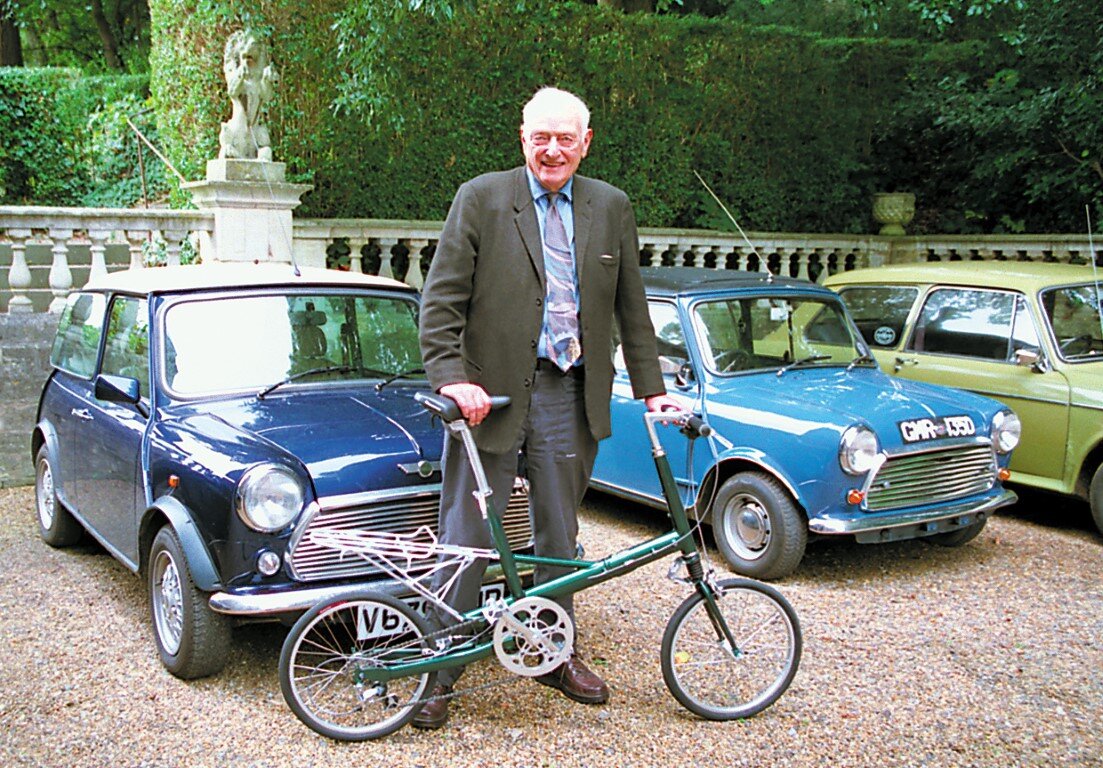ALEX MOULTON - INTERVIEWED BY PETER BARKER
The January 2021 issue of CooperWorld, the magazine of the Mini Cooper Register, features an interview with Dr. Alex Moulton by Mini aficionado Peter Barker. It is really two interviews in one, being based on conversations between Peter and Alex Moulton in 2001 and 2012. A lifelong Mini enthusiast, Peter worked for Alex Moulton in the 1980s and so was perfectly placed to gain these valuable insights - and one of the very few brave enough to turn up at The Hall in a BMW MINI. He has recently been appointed as a Trustee here at the Alex Moulton Charitable Trust.
The text below is reproduced courtesy of Peter Barker, and with thanks to the Mini Cooper Register and MiniWorld magazine.
______
Alex Moulton was responsible for the Mini’s rubber cone suspension and for the Hydrolastic suspension that featured on certain Mini models built between 1964 and 1971. His professional friendship with Alec Issigonis led to a whole host of innovations, as he told me in interviews with him for MiniWorld magazine in 2001 and 2012.
“After the Second World War I was determined to move my family firm, Spencer-Moulton based at Bradford on Avon in Wiltshire, from the manufacture of rubber suspension for railway coaches into automotive suspension. I had heard of Alec Issigonis by reputation and we met socially before we worked together. Issigonis was working at Alvis in Coventry at that time, on a new large car to replace their famous but dated ‘Grey Lady’ model. He was given a free hand to do what he liked, more or less. Alec had heard of an experimental rubber suspended Morris Minor that Jack Daniels and I had built at Cowley. It had been driven over 1000 miles on the pavé at MIRA, an unimaginably tough test that the standard car would not have been able to withstand..
Following my experimental developments of the mid 1950s Issigonis was determined that he should have interconnected fluid and rubber suspension on his Alvis. Interconnecting front and rear suspension units with fluid in pipes meant that the pitch mode was separated from bounce and roll. As a result the car moved smoothly over a bump in the road giving a much higher quality ride”. (The Alvis was an interesting technical exercise but it never reached the production line).
“Leonard Lord and George Harriman had formed BMC in the mid ‘50s by merging Austin and Morris. Lord was determined to make a range of new and innovative cars so he plucked Alec Issigonis back from Alvis to design them. The Suez crisis of 1957 and consequent patrol rationing meant that tiny bubble cars, mostly of German manufacture and including some BMW-Isetta models began to flood the roads. Lord wanted to sweep them away and so Issigonis got the order to build the smallest of his new cars first, a proper miniature four-seater. Issigonis told Lord that he wanted me to be involved with my suspensions and so I went to ‘the Kremlin’ (BMC headquarters) at Longbridge to meet him. He looked at my portfolio of experimental work and said ‘If you’ve done this you’ll do more.’ He was very gruff but I got the OK.
I formed Moulton Developments to work on the Mini suspension and other projects, BMC took a shareholding and paid all the costs of development. This left me free to do the things I wanted to do. We actually developed the principles of the Hydrolastic system during the 1950s but it wasn’t ready for production in time for the Mini’s launch in 1959. I had previously designed the rubber cone suspension system – it was a specially shaped rubber and metal unit that gave a smoothly rising spring rate. This meant that when the car cornered or went over a bump the suspension stiffened up as it was deflected. When practically undeflected (ie the car was at rest or on a smooth road) the rate was low and so the ride was soft. We fitted this system to the original Mini of 1959. It was a parody of the interconnected hydraulic system but that simply wasn’t ready in time.
Issigonis took Jack Daniels from Cowley and got together a small team, no more than six people. Jack had been running an experimental transverse-engined, front wheel drive Morris Minor on the road over the snowy winter of 1956-57. It performed particularly well in the wintery conditions and Leonard Lord and George Harriman were well aware of the benefits of the transverse set up, as Jack parked it outside ‘the Kremlin’ every day where he knew they could see it. Issigonis’s team designed and developed the Mini from start to finish in 27 months, a fantastically short time. They had total authority from Lord; the whole of BMC was at their disposal plus all of the component suppliers. The whole of the Midlands was committed to the new project.
It is unfair to say that the Mini was underdeveloped when it was introduced. OK there were some small problems such as the floorpan sealing, but when you think of all the technical innovation in that one small vehicle it was amazingly right, and look how little fundamental change it needed in the following 40 years!”
The Hydrolastic system was introduced for the Mini saloon models in 1964. Hydrolastic suspension involved similar rubber cones to the ‘dry’ set up but they formed a displacer unit with an integral diaphragm and damper valves. They were filled with a water and antifreeze mixture and interconnected front to rear via pipes under the car. This gave the car a rising and falling motion rather than the sudden pitching of the rubber cone system. Alex Moulton took up the story once more..
“The Morris 1100 was introduced in 1962 with my first Hydrolastic installation. It was a great success and Ford in particular were very upset by it. Dunlop and Moulton Developments took some time to make a unit small enough to fit in a Mini but it was done by the early 1960s. The majority of the Mini’s racing and rallying success was achieved with the Hydrolastic cars. (Although it should be noted that many serious competitors including the BMC Works Team fitted taps into the system to isolate one displacer from another). The whole Mini racing thing was started by John Cooper. We never thought about racing during the design phase, we were worried about safety, particularly when the car was overloaded with lots of students aboard or such like.”
The final phase of the Moulton suspension system evolution was Hydragas. In this ultimate version of the interconnection principle the rubber cone was replaced by gas under pressure. Hydragas was introduced with the unloved Austin Allegro in 1973 and continued in use in various BL/Austin Rover/Rover/MG Rover vehicles until the end of MGF production in 2002. Hydragas was never fitted to a production Mini although Alex Moulton’s own 1966 Cooper S was fitted with the system as an experiment. During our interviews we took a ride in first the Mini Cooper S and then a 1980 Austin Metro fitted with the system. Both cars rode very well.
“The prototype Metro installation was the ultimate expression of interconnection for a small car (and resulted in the Rover Metro having fully interconnected Hydragas suspension from 1990). I showed the Mini Cooper S with Hydragas to BMW during the early development of the MINI and I am certain that they were impressed. We then worked with Rover on the Minky 2, a one-off based on extended Mini sheet metal that was essentially a test rig for a potential suspension set up for BMW’s new car. However, there was a major personnel change at board level. Bernd Pischetsrieder with whom I had had encouraging discussions left, and the decision was taken that the new MINI should be wholly conventional in its suspension.”
Alex Moulton had some forthright views in 2001 to share on the then recently released BMW MINI. “It’s enormous. The original Mini was the best packaged car of all time, the MINI is an example of how not to do it. The interior space is not much bigger than the old Mini but the MINI is huge on the outside and weighs the same as the Austin Maxi. The crash protection has been taken too far. I mean what do you want, an armoured car? With the original Mini we set out to prevent accidents by having excellent handling, not by cushioning people from the consequences of their own folly. The original Mini was the absolute apogeé of the philosophy of built in safety via the handling, people avoided accidents by driving around them. The suspension of the MINI Cooper is set far too stiff giving a most uncomfortable ride.”
In the year 2000 Alex Moulton gave a paper to the Institution of Mechanical Engineers in London entitled Moulton Suspension, Past and Future. In it he stated:
“There will be a new breed of small cars, sufficient in size for the typical urban journey but with the convenience in driving on crowded roads for the longest journey, provided they have big car ride, comfort and absolute security of handling. I suggest that these cars will have the Issigonis layout of transverse engine and front wheel drive.”
Twenty years on from these remarks Alex Moulton’s predictions seem to have been realised and with electric motors set to replace the internal combustion engine all too soon he may be even more correct than he could have imagined!
© Peter Barker 2021
Alex Moulton in front of his workshop, with his 1966 Mini Cooper S and a Moulton Jubilee bicycle.
The original MiniWorld article Smooth Talking from 2012.
Alex Moulton with the Cone Spring and his Rover Mini.
Alex Moulton with a Bridgestone Moulton bicycle with the splendid backdropof his two Minis and a three-door Austin 1100.
Great Man, Mini Car. Alex Moulton at The Hall.






